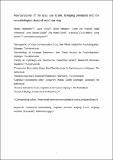Files in this item
Neuroanatomy of the grey seal brain : bringing pinnipeds into the neurobiological study of vocal learning
Item metadata
| dc.contributor.author | Hoeksema, Nienke | |
| dc.contributor.author | Verga, Laura | |
| dc.contributor.author | Mengede, Janine | |
| dc.contributor.author | van Roessel, Corné | |
| dc.contributor.author | Villanueva, Stella | |
| dc.contributor.author | Salazar-Casals, Anna | |
| dc.contributor.author | Rubio-Garcia, Ana | |
| dc.contributor.author | Ćurčić-Blake, Branislava | |
| dc.contributor.author | Vernes, Sonja C. | |
| dc.contributor.author | Ravignani, Andrea | |
| dc.date.accessioned | 2021-09-22T11:30:06Z | |
| dc.date.available | 2021-09-22T11:30:06Z | |
| dc.date.issued | 2021-10-25 | |
| dc.identifier | 275773538 | |
| dc.identifier | 531f0d4a-e7fb-48f6-ae91-0d89b9b0c4a2 | |
| dc.identifier | 34482729 | |
| dc.identifier | 000693558500018 | |
| dc.identifier | 85115818830 | |
| dc.identifier.citation | Hoeksema , N , Verga , L , Mengede , J , van Roessel , C , Villanueva , S , Salazar-Casals , A , Rubio-Garcia , A , Ćurčić-Blake , B , Vernes , S C & Ravignani , A 2021 , ' Neuroanatomy of the grey seal brain : bringing pinnipeds into the neurobiological study of vocal learning ' , Philosophical Transactions of the Royal Society B: Biological Sciences , vol. 376 , no. 1836 , 20200252 . https://doi.org/10.1098/rstb.2020.0252 | en |
| dc.identifier.issn | 0962-8436 | |
| dc.identifier.other | RIS: urn:5D21B826CAB4C7FA4039AF0ED56CC702 | |
| dc.identifier.other | ORCID: /0000-0003-0305-4584/work/99804766 | |
| dc.identifier.uri | https://hdl.handle.net/10023/23997 | |
| dc.description | N.H. is supported by funding from an International Max Planck Research School (IMPRS) for language sciences fellowship grant, and the work of N.H. and S.C.V. was supported by a Max Planck Research Group (MPRG) awarded to S.C.V. The work of L.V. and A.R. was supported by a Max Planck Research Group (MPRG) awarded to A.R. S.C.V. was also supported by a Human Frontiers Science Program (HFSP) Research grant (grant no. RGP0058/2016) and a UKRI Future Leaders Fellowship (grant no. MR/T021985/1). | en |
| dc.description.abstract | Comparative animal studies of complex behavioural traits, and their neurobiological underpinnings, can increase our understanding of their evolution, including in humans. Vocal learning, a potential precursor to human speech, is one such trait. Mammalian vocal learning is under-studied: most research has either focused on vocal learning in songbirds or its absence in non-human primates. Here, we focus on a highly promising model species for the neurobiology of vocal learning: grey seals (Halichoerus grypus). We provide a neuroanatomical atlas (based on dissected brain slices and magnetic resonance images), a labelled MRI template, a three-dimensional model with volumetric measurements of brain regions, and histological cortical stainings. Four main features of the grey seal brain stand out: (i) it is relatively big and highly convoluted; (ii) it hosts a relatively large temporal lobe and cerebellum; (iii) the cortex is similar to that of humans in thickness and shows the expected six-layered mammalian structure; (iv) there is expression of FoxP2 present in deeper layers of the cortex; FoxP2 is a gene involved in motor learning, vocal learning, and spoken language. Our results could facilitate future studies targeting the neural and genetic underpinnings of mammalian vocal learning, thus bridging the research gap from songbirds to humans and non-human primates. Our findings are relevant not only to vocal learning research but also to the study of mammalian neurobiology and cognition more in general. | |
| dc.format.extent | 4 | |
| dc.format.extent | 236343 | |
| dc.language.iso | eng | |
| dc.relation.ispartof | Philosophical Transactions of the Royal Society B: Biological Sciences | en |
| dc.subject | Comparative neuroanatomy | en |
| dc.subject | Magnetic resonance imaging | en |
| dc.subject | FoxP2 | en |
| dc.subject | Language evolution | en |
| dc.subject | Bioacoustics | en |
| dc.subject | Halichoerus grypus | en |
| dc.subject | QH426 Genetics | en |
| dc.subject | QL Zoology | en |
| dc.subject | 3rd-DAS | en |
| dc.subject | AC | en |
| dc.subject.lcc | QH426 | en |
| dc.subject.lcc | QL | en |
| dc.title | Neuroanatomy of the grey seal brain : bringing pinnipeds into the neurobiological study of vocal learning | en |
| dc.type | Journal article | en |
| dc.contributor.sponsor | UK Research and Innovation | en |
| dc.contributor.institution | University of St Andrews. School of Biology | en |
| dc.contributor.institution | University of St Andrews. St Andrews Bioinformatics Unit | en |
| dc.identifier.doi | https://doi.org/10.1098/rstb.2020.0252 | |
| dc.description.status | Peer reviewed | en |
| dc.identifier.grantnumber | MR/T021985/1 | en |
This item appears in the following Collection(s)
Items in the St Andrews Research Repository are protected by copyright, with all rights reserved, unless otherwise indicated.

